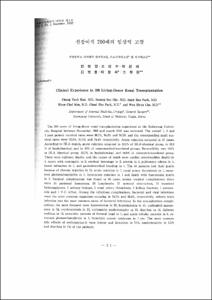KUMEL Repository
1. Journal Papers (연구논문)
1. School of Medicine (의과대학)
Dept. of Internal Medicine (내과학)
신장이식 200예의 임상적 고찰
- Keimyung Author(s)
- Park, Sung Bae; Kim, Hyun Chul; Park, Choal Hee; Cho, Won Hyun
- Journal Title
- 대한이식학회지
- Issued Date
- 1992
- Volume
- 6
- Issue
- 1
- Abstract
- The 200 cases of living-donor renal transplantation experience at the Keimyung University Hospital between November 1982 and march 1992 was reviewed. The overall 1, 2 and 3 year patient survival rates were 96.2%, 94.8% and 90.5% and the corresponding graft survival rates were 92.6%, 83.9% and 74.4% respectively. Acute rejection occurred in 67 cases. According to HLA match, acute rejection occurred in 12.5% of HLA-identical group, in 32.8 % of haploidentical, and in 40% of mismmatched/unrelated groups. Reversibility was 100% in HLA identical group, 66.7% in haploidentical, and 84.6% in mismatch/unrelated group. There were eighteen deaths, and the causes of death were cardiac arrest (sudden death) in 4, sepsis with meningitis in 3, cerebral hemorage in 2, uremia in 2, pulmonary edema in 2, bowel infraction in 1, and gastrointestinal bleeding in 1. The 41 patients lost their grafts because of chronic rejection in 24, acute rejection in 7, renal artery thrombosis in 1, recurrent glomerulonephritis in 2, hyperacute rejection in 1 and death with functioning grafts in 6. Surgical complications was found in 86 cases, among surgical complications there were 24 perirenal hematoma, 24 lymphocele, 17 ureteral obstruction, 12 transient hydronephrosis, 5 urinary leakage, 2 renal artery thrombosis, 2 kidney fracture, 1 ureterocele and 1 V-U reflux. Among the infectious complications, bacterial and viral infections were the most common organisms occuring in 54.5% and 36.6%, respectively, urinary tract infection was the most common cause of bacterial infections. In the non-infectious complications, the most frequent were hypertension in 92, hyperkalemia in 45, cushingoid appearance in 34, erythrocytosis in 23, cyclosporin nephrotoxicity in 19, diarrhea in 14, diabetes mellitus in 12, avascular necrosis of femoral head in 7, and acute tubular necrosis in 6, recurrent glomerulonephritis in 3, hemolytic uremic syndrome in 1 etc. The most common side effects of cyclosporine-A were tremor and hirsutism in 56%, nephrotoxicity in 6.5% and diarrhea in 7% of the patients.
- Alternative Title
- Clinical Experience in 200 Living-Donor Renal Transplantation
- Publisher
- School of Medicine
- Citation
- 한창엽 et al. (1992). 신장이식 200예의 임상적 고찰. 대한이식학회지, 6(1), 21–30.
- Type
- Article
- ISSN
- 1598-1711
- 파일 목록
-
-
Download
 oak-bbb-03312.pdf
기타 데이터 / 1.6 MB / Adobe PDF
oak-bbb-03312.pdf
기타 데이터 / 1.6 MB / Adobe PDF
-
Items in Repository are protected by copyright, with all rights reserved, unless otherwise indicated.